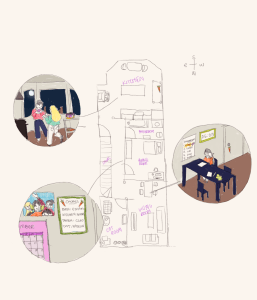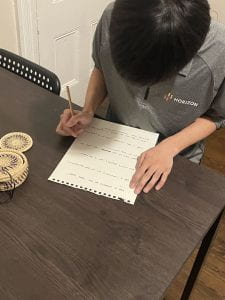I struggled quite a bit with this project but I am extremely happy with how it turned out in the end.
The original concept for this game was to design a tile based board game where players must advance, however they have the opportunity to determine their own future. Just like in life, there is a game of chance on how much progress will be made in each round, and they may become more successful or unsuccessful through their own planning and design. I wanted to design the game in such a way that playing collaboratively would help both players succeed, however inherently incentivized them to play selfishly. This part of the game was heavily inspired by the game (sorry I don’t know the title of it), where the players were supposed to work together to win, however the directions never explicitly stated they should do so. Similarly, through the design of my game, I wanted to see what emergent gameplay would develop through intentionally vague rules, and see if players would force themselves into expected boardgame behavior, or if they would manipulate the design for their own gain.
On the first iteration of my game, players could place tiles anywhere, there were no connection points, however despite this they believed they could only place their tiles on the preset board. This is why I added connection points to the pieces. It also adds more strategy where players can block tiles from being placed on top of certain tiles. Additionally, I realized the player who went last had the most advantageous position for altering tiles, so I added a line into the instructions about how the player who goes last becomes the new first player for the next round.
On the second iteration, players were more limited on their tile placements, increasing the amount players strategized, however players still never placed tiles outside the preset board.
After these trials, I realized I needed to define my directions more explicitly, and also hint in the directions without explicitly stating so towards this desired emergent behavior. One of the key lines I added was “Players must move forward, they may not return to the tile they just came from”. This instruction was confusing to the playtest group as they assumed there was only ever one path, and despite voicing this confusion, they still never placed tiles outside the path.
While I was developing the tiles for this game, I realized that the board for the game may give away the behavior I desired from the players too obviously if I designed a preset board then put indents across the board outside of the main path. While this was a solution to hinting towards having players place tiles outside the original board, it was more obvious than I wanted. Eventually, I realized I could simply make the starting board out of the same tiles I was designing for the players, since these were individual tiles, I would have players assemble their own board at the beginning of the game and hopefully the act of doing this would help them realize that the starting board was not set in stone. This new design for the board also meant that players who realized it, could also modify the starting board mid game which was not possible in the past tests. I really enjoyed this new design and playtested to see how it affected player behavior.
While several of my earlier iterations of this game were unsuccessful on the emergent gameplay front, I had confidence that I might be more successful after I prototyped a more polished version of the tiles for this game, and I was right! By the time the tiles were designed, I had also rewritten the rules a few times to best encourage players to do more unexpected behavior and I think the design of the tiles also encouraged this. See end of post for the final game rules.
While playtesting this game I learned that players could alter the intended way to play if I did not word my directions very clearly so after each iteration, I attempted to modify the rules so they would be as clear as possible for the intended game play, while still leaving parts intentionally vague where I wanted players to discover they had more freedom then they may expect. As altering the starting board is an unexpected behavior, many of the people who playtest this game for the first would often only place their tiles on top of the starting board, and never mutated the shape of the board.
Another result of these playtests which was unexpected is that players were always ‘selfish’ in that they would play the game so they could win and no one else could. While this game is designed to be easy to win between 2 people, players never collaborated. Maybe because its completely possible to win on your own. I think its interesting to watch how players strategize in this game. Since the players designed the starting board, it was interesting to find that some players would isolate themselves and collect points in a 2×2 tile area, while others tried to determine the shortest path from the start to the end and place their tiles along this path. Additionally, players are hesitant to touch other players tiles or move the start or end.
I worry that depending on how much freedom the players realize they have, it becomes very easy to win this game, however because this is the case, players who play this game several time seem to enjoy how the strategy mutates along with their discovery of different interpretations of the rules.
I really enjoyed our discussions in class of games with ‘loose’ rules. We had discussed another students “graveyard” game and also I was inspired by how many designers of art games modify the way players interact with the pieces in order to change the expected interaction between players and the game. Thinking back to Mary Flanagan’s ‘giant joysick’ and how increasing the size of the controller forces people to move a single controller collaboratively, I wanted to design my pieces in a way where the core focus of the game is on placing the tiles and modifying the game space instead of acting on top of a designated board design. I also enjoyed how players had interacted in my score from the first project and wanted to return to that idea of mutating the game as you play. Additionally I wanted to continue with the concept I had for the intervention assignment where I tested if people would act different given signs in a test setting or if we have become so conditioned by tests that they wouldn’t even consider another action then simply taking the test. I wanted “gamify” this concept more where it was more replayable when players discovered their freedoms. I really enjoy games with greater player freedom and wanted to design a game where the players own freedom is determined by themself, similar how in life we are expected to follow a certain path, however people have more control over their direction then they know, and are often fearful to stray from what is expected of them. Just like in life, the only thing the player can not do is remain stationary, every turn they must move forward, even if it is just one tile. Even if they are not moving towards the “end” they are still making progress, often with a side goal (like collecting coins) before making their way to the end.

first playtest

tile development! I learned how to 3d print and vinyl cut while making this project!

first playtest after tiles were designed/printed

first playtest after players were able to design their own starting board
Rules: @ GAME START - players should connect 17 tiles to make the board, this should include the "start" and "end" tiles. All pieces should be connected; no islands - all players should choose a color and place their player on the start tile - all players begin with 4 tokens, ensure that there are 8 tokens left in the pot - players should roll a die to determine who starts. @ EACH ROUND rounds consist of 2 phases. all players should complete the first phase before moving to the second phase PHASE 1: TILES players must choose one of the following actions: - place a tile - move/rotate a tile - remove a tile - skip your turn for this phase * tiles with a player on them may not be modified. * adjacent tiles must lie flat, 2 male connections cannot be adjacent. * adjacent tiles must be on the same plane * if you must lift tiles to complete your action, this action is invalid. PHASE 2: MOVE each player should roll the d4 and move that many spaces * players may not move backwards (back onto the tile they just came from) if a player lands on: - THEIR OWN COLOR TILE: take your dice roll X2 tokens from the pot. if there are no coins in the pot, do nothing - ANOTHER PLAYER'S COLOR TILE: give your dice roll of your tokens to the player whose color the tile matches to - NON-COLORED TILE: pay 2 of your tokens to the pot @ END OF EACH ROUND: player that went last, should go again and begin the next round @ GAME END This game ends for each player when they land on the "end" tile. At this point, they no longer take a turn even if other players continue If a player finished the game with 9+ tokens, they win.





